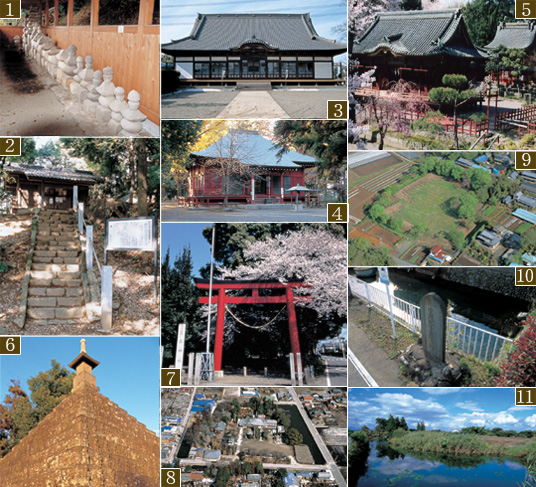Nitta-no-sho National Historical Site

1 Enpuku-ji (Enpuku Temple)
This is a Buddhist temple founded by Masayosi Nitta (from 1187 to 1257). Within the grounds, there are twenty pagodas and a five-storied pagoda serving as family tombs. One of the tombs belongs to Yoshisada’s grandfather and its inscription tells us that he died on June 11th in 1324.
2 Junisho Jinja (Junisho Shrine)
This shrine is located in the west part of Enpuku-ji (Enpuku Temple). Sixteen images of god carved in wood are enshrined here, and five of them have an inscription that dates them to 1259. They are all about 30 centimeters tall. The shrine itself is believed to have been constructed as the main focus of the twelve branches nearby. It is called Junisho which means twelve places.
3 Souji-ji (Souji Temple)
This temple is located on the premises of the Nittas. The scale of the site indicates that its owner family must have been in a politically powerful supervisory position. In regard with its ownership, there are several views. Some say the site belonged to Yoshishige Nitta, or that after his grandson Masayoshi Nitta’s downfall, Yoriuji Serada, a blood relative of the Nittas, owned it. Others say that Yoshisada Nitta was a resident on this site.
In the end of the Edo Era, this temple was used as a school to give lessons based on the Shingon-shu (the Shingon Sect of Buddhism).
4 Choraku-ji (Choraku Temple)
This is the first Zen temple in the eastern Japan which was founded in 1221 by Yoshisue Tokugawa, a son of Yoshishige Nitta. The first priest to practice here was one of the leading disciples of Eisai, who was the founder of the Zen Sect in Japan. At that time, approximately five hundred monks practiced asceticism here. Some of them even went to China to exchange their opinions and views in order to promote the establishment of the foothold of Japanese Buddhism. After Ieyasu Tokugawa spread his political power and influence over the Kanto area, this came under the control of the Tendai Sect with Tenkai Sojo as its chief priest.
5 Tosho-gu (Tosho Shrine)
When Iemitsu Tokugawa, the third general of the Edo Era, reconstructed Nikko Tosho-gu in Tochigi Prefecture, the chief priest of Choraku-ji (Choraku Temple) requested that its old outer shrine and a pagoda be relocated into the precincts of Choraku-ji (Choraku Temple). Important cultural properties are abundant both inside and outside the shrine.
6 Myouou-in (Myouou Temple)
Inside of this temple are two statues of gods. One of them is known as Nitta Fure Fudo, a god believed to have transformed himself to be a Buddhist monk and who informed the Nitta clan of Yoshisada’s attack to destroy the Kamakura government. This statue is about 5.5 centimeters tall and made of platinum. In the precincts of the temple stands a very rare tower called Sentai-fudoson that is shaped like a pyramid. It was founded in the Edo Era.
7 Ikushina Jinja (Ikushina Shrine)
It is believed that Yoshisada Nitta raised his army here against the Kamakura government in 1333 in which approximately one hundred fifty people of the Nitta clan mounted their horses. On the left hand side of the gate a mound remains where Yoshisada sat and directed his army. There is another mound in front of the precincts where he actually raised his army. A sacred tree on which Yoshisada placed his regimental flag still exists here. On May 8th of every year, a festival called “kabura-ya sai” (whistling arrow festival) is held. The local residents worshipping this shrine reenact the scene of the Nitta clan’s departure to the battle.
8 Sorimachi Yakata Ato (The Former Site of the Sorimachis’ Mansion)
There are several ideas about the ownership of this site. Some say that Yoshisada Nitta lived here after he attained manhood. Others say the site owners were the Ichinois or the Ootachis. In fact, the site now belongs to Shomei-ji (Shomei Temple). On January 4th of every year, many people attend a fair held at this temple to exorcise their evil spirits. Behind the main hall of the temple a pond still remains called “Nakazu-no Ike” (the pond where no frogs croak). Its name came from an anecdote of Yoshisada Nitta, who yelled at the croaking frogs not to bother him, and since then, the frogs have stopped croaking at this pond. There is also a Japanese garden designed in the Muromachi Era, here.
9 Eda Yakata Ato (The Former Site of the Edas’ Mansion)
Yukiyoshi Eda was the owner of this site. He was a descendent of Yoshisue Nitta who was a son of Yoshishige Nitta. When Yoshisada Nitta raised his army in 1333, Yukiyoshi Eda followed him as a general and attacked the Kamakura government. After the unsuccessful battle, he escaped to the Hiroshima area and changed his last name into Morishita. About 260 years later, his descendant moved back to his ancestors’ land. This site still has the fort of 80 meters by 100 meters surrounded by the moat from that time.
10 Judono Suigen (Judono Springs)
This is now a small pond of 30 meters by 10 meters surrounded by a stone wall, however, it used to be an important canal of the manor. A historical document shows that Muneuji Ootachi and Masatsune Iwamatsu had a conflict over the right to use the irrigation canal from the springs.
11 Yataijin Suigen (Yataijin Springs)
Water still gushes out naturally at the site. It is the source of the Ishida River and was an important lifeline of the Nitta-no-sho (Nitta Manor). Surrounding the site, there are some items remaining of the ancient Jomon Era about 4,000 years ago. Wild plants around the springs indicate this site itself is a natural treasure.
 Yabuzuka Onsen (Yabuzuka Hot Spring)
Yabuzuka Onsen (Yabuzuka Hot Spring) Nitta-no-sho National Historical Site
Nitta-no-sho National Historical Site Recommended Tours of Sightseeing
Recommended Tours of Sightseeing


